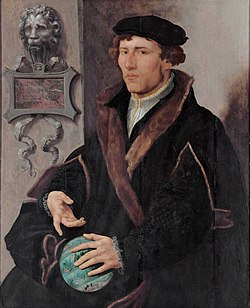Gemma Frisius
| Gema Frizo (1508-1555) | |||||
|---|---|---|---|---|---|
 germana fizikisto kaj instrumento-fabrikanto.
| |||||
| Persona informo | |||||
| Jemme Reinierszoon | |||||
| Naskonomo | Regnier Gemma | ||||
| Naskiĝo | 9-a de decembro 1508 en Dokkum, | ||||
| Morto | 25-a de majo 1555 en Loveno, | ||||
| Mortis pro | Naturaj kialoj | ||||
| Mortis per | Rena malfunkcio | ||||
| Lingvoj | latina • flandra vd | ||||
| Ŝtataneco | Dek sep Provincoj | ||||
| Alma mater | Universitato de Loveno | ||||
| Familio | |||||
| Infanoj | Cornelis Gemma | ||||
| Profesio | |||||
| Okupo | matematikisto instrumentofaristo astronomo universitata instruisto kuracisto kartografo globe maker (en) | ||||
| Aktiva en | Loveno vd | ||||
| |||||
| vd | Fonto: Vikidatumoj | ||||
Regnier Gemma Frisius (1508-1555) estis germana fizikisto, matematikisto, kartografo, filozofo kaj instrumento-fabrikanto[1]. Li kreis gravajn terglobojn[2], plibonigis la tiamajn matematikajn instrumentojn kaj aplikis matematikon per novaj manieroj pri maraj esplorado kaj navigado. Li studis en la Universitato de Loveno kie li doktoriĝis pri Medicino kaj tie li restis la tutan tempon de sia vivo. Liaj instrumentoj estis laŭdataj de Tiko Braho (1546-1601). En 1533, li unuafoje priskribis la metodon pri triangulado nuntempe uzata por mezuradoj.
Post dudek jaroj li estis la unua kiu priskribis precizan horloĝon[3] por determinado de la longitudo. Johano Baptisto Morin (1583-1656)[4] ne kredis ke la metodon de Frizo por kalkulado de longitudo povus funkcii kaj eldiris: "Mi ne scias ĉu la diablo sukcesos krei metodon pro mezuri la longitudoj, sed estas frenezo de homo provi". Estis liaj lernantoj Gerardo Merkator (1512-1594), kiu ankaŭ fariĝis lia kunlaboranto, Johano Stadio (1527-1579), John Dee (1527-1608), Andreas Vesalius (1514-1564)[5] kaj Renbertus Dodonaeus (1517-1585).
Selektita verkaro
[redakti | redakti fonton]

- Cosmographia (1529) von Petrus Apianus, kun notoj de Gema Frizo, 1584
- De principiis astronomiae et cosmographiae (1530)
- De usu globi (1530, 1547)
- Libellus de locorum describendorum ratione (1533)
- Arithmeticae practicae methodus facilis (1540, 1571)
- De annuli astronomici usu, (1540)
- De radio astronomico et geometrico (1545, 1558)
- Gemmae Frisii de astrolabo catholico liber: quo latissime patentis ..., 1556
- De principiis astronomiae et cosmographiae, 1553, Rainer Gemma Frisius
- Gemmae Phrysii Medici Ac Mathematici, De Orbis Divisione Et Insvlis ..., 1576, Rainer Gemma Frisius
Literaturo
[redakti | redakti fonton]- Mercator: The Man Who Mapped the Planet, Nicholas Crane
- Military Surveying and Topography: The Pratical Dimension of Renaissance ..., Veltman, Kim
- History of Cartography, Leo Bagrow
- Panorama, Power, and History: Vasari and Stradano's City Views in the ... Arkivigite je 2015-04-02 per la retarkivo Wayback Machine, Ryan E. Gregg
- Biographical Encyclopedia of Astronomers, Thomas Hockey, Katherine Bracher, Marvin Bolt, Virginia Trimble, JoAnn Palmeri, Richard Jarrell, Jordan D. Marché, F. Jamil Ragep
- Map Of A Nation: A Biography Of The Ordnance Survey, Rachel Hewitt
- Francis Drake in Nehalem Bay Revised Editon, Garry Gitzen
- The Cosmographia of Sebastian Münster: Describing the World in the Reformation, Matthew McLean
- Terrestrial and Celestial Globes Volume 1 Their History and Construction ... Arkivigite je 2016-03-04 per la retarkivo Wayback Machine, Edward Luther Stevenson
Vidu ankaŭ
[redakti | redakti fonton]Referencoj
[redakti | redakti fonton]- ↑ Copernicus in the Cultural Debates of the Renaissance: Reception, Legacy ..., Pietro Daniel Omodeo
- ↑ Oceans: A Scientific History of Oceans and Marine Life, Michael Allaby
- ↑ The Human Organization of Time: Temporal Realities and Experience, Allen C. Bluedorn
- ↑ The Theory and Practice of Finding the Longitude at Sea Or Land ..., Volume 1
- ↑ The Scientific Revolution in National Context[rompita ligilo], Roy Porter














